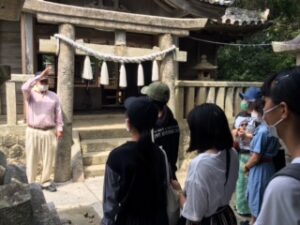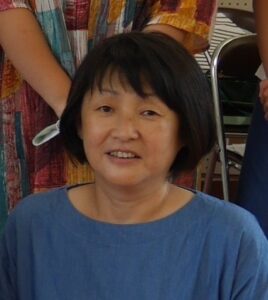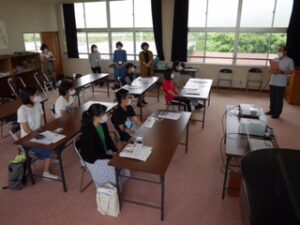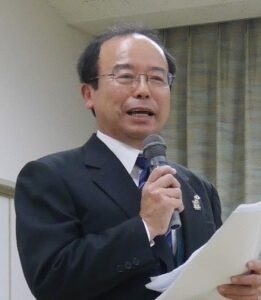Vol. 2 10/11/2020
Fieldwork at Ryuo Shrine
On August 3, Chief Shrine Parishioner Toyoyuki Saruma gave us a tour of the shrine.
Ryuo Shrine is a place to pray for safety on the sea and to protect people involved in the fishing industry. Ryuo is also the god of rain. In the shrine grounds stands a Japanese sea fig tree estimated to be around 350 years old and is designated as a cultural asset by Wakayama Prefecture. Saruma explained that the tree is also called the “strangling tree” because the tree's new shoots look like they are strangling the original tree with their roots.
This was the first time for all but two of the first-year juniors to visit the temple, and they listened intently to the explanations delivered by the shrine parishioner.

Mr. Saruma explains the history of the shrine.
Teacher's Self Introduction
 My name is Misa Izuishi, and I am an instructor for the Kataribe Junior program.
My name is Misa Izuishi, and I am an instructor for the Kataribe Junior program.
My participation in this project has led me to learn more about the history of Mio. I feel that this history should become more widely known and therefore be preserved for future generations.
This is because I believe that there is much we can
learn from the history of emigrants that can help us when we consider how we want to live in the future. I want the younger generation to know about this history, and that is why I keep coming to Mio.
The juniors are eager to learn with the help of the people of Mio. I would be very happy if you could watch over them and support them in their endeavors.
Thank you for your continued support.
Japanese ver. 語り部だより 第2号
Vol. 1 10/9/2020
Kataribe Juniors start!
On June 21, the opening ceremony for the second class of Kataribe Juniors was held at the former Mio elementary school. The opening of the class was postponed from April due to the pandemic.
There were seven students in the second class. Two of them are continuing students from the first class. Of the five new students, two are from Mihama Town and three are from Gobo City.
Fumiya Yanagimoto, the leader of Kataribe Juniors, delivered a welcome address: "Welcome to Kataribe Juniors*. I know it is not easy for you to come to Mio every Sunday, but it is meaningful for you to learn here in Mio, so please make the effort to join us.”
After that, the instructors and juniors introduced themselves.
Some of the new juniors shared their motivations for participating in the program: “I want to learn more English,” “I came here with my sister when she was in the first class, and I thought it would be fun and I wanted to try it, too,” “I live in Mihama Town, but I don't know anything about Mio, so I want to learn more about the town,” “My friends participated in this program, and they seemed to have a lot of fun, so it made me want to learn about Mio,” “As a Shoyo junior high school student, I wanted to learn more about Mihama Town.”
*Kataribe Juniors: Young people will learn about the history of Mio and Canadian immigrants and take on the role of telling their stories. They will help revitalize the Mio area as part of their responsibility to Japan and the rest of the world.

Juniors have orientation.
Greeting
 Fumiya Yanagimoto, Leader of Kataribe Juniors
Fumiya Yanagimoto, Leader of Kataribe Juniors
Kataribe Juniors started in April 2018, and this year the second class of students started their activities.
The children are learning about the history of Mio, the history of the Canadian immigrants, and how to preserve this history for future generations. Throughout this process, participants encounter many discoveries, surprises, miracles and emotions.
The Juniors can share in the enterprising spirit of their ancestors who lived on the ocean and looked overseas. The Mio Canadians, who overcame racial differences, and despite being at the mercy of discrimination and war, carved out meaningful lives for themselves.
We hope that the children who study here in Mio will continue to receive warm encouragement from the local community, dreaming of the day when they can play an active role in the world as “English storytellers” for a new era.
Japanese ver. 語り部だより 第1号
